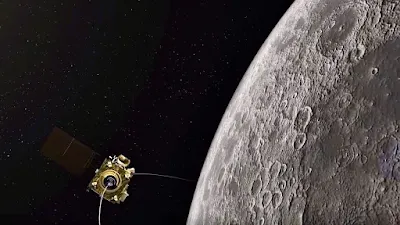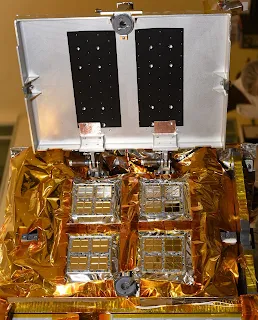chandrayaan-2 mission’s data released: latest news from isro
Chandrayaan-2 Mission's Initial Data Released: ISRO
latest news from isro
The Indian Space Research Organization (Isro) has delivered the main arrangement of information from the eight instruments on board India's second lunar mission Chandrayaan-2. The orbiter, which has finished sixteen months around the moon in lunar circle, was dispatched on July 22, 2019 and embedded into the lunar circle on August 20.
On finish of one year of the orbiter being in space, Isro had said that the shuttle was 'sound', execution of subsystems were typical, and there was satisfactory locally available fuel to stay operational for around seven years.
Here is all you require to think about the orbiter:
- Chandrayaan-2, depicted as the most intricate mission ever embraced by Isro, cost not exactly a large portion of the financial plan of Hollywood blockbuster 'Vindicators Endgame'. The complete expense of the mission is assessed at 124 million US dollars, while the film has an expected financial plan of near 356 million US dollars.
The mission made India the fourth country after the United States, Russia and China to land a rocket on the Moon.
- Chandrayaan-2 comprised of three missions clubbed together – the orbiter that would hover around the moon, the Vikram lander that was to make a delicate arriving close to the south pole of the moon, and the Pragyan meanderer that was to investigate the lunar surface and notice water ice. The lander and meanderer were demolished during the endeavored arriving in September, 2019.
The lander of Chandrayaan 2, 'Vikram', was named after the pioneer of India's space program, physicist Dr Vikram Sarabhai.
- The information from seven out of the eight instruments was gathered by the Indian Space Science Data Center at Karnataka's Byalalu, where it was set up in the Planetary Data System 4 (PDS4) design for public delivery prior to being peer-surveyed deductively. It was then delivered through the PRADAN entry facilitated by ISSDC at https://pradan.issdc.gov.in
ISRO RLV TD Indian Reusable Launch Vehicle
ISRO mangalyaan has discover the red planet is losing its air to space
On completion of one year of the orbiter being in space, Isro had said that the spacecraft was ‘healthy’, performance of subsystems were normal, and there was adequate onboard fuel to remain operational for about seven years.
Chandrayaan-2
The Chandrayaan-2 mission was successfully launched on 22nd July 2019 at 14:43 hrs by GSLV MkIII-M1 from Satish Dhawan Space Centre (SDSC), Sriharikota. After a series of Earth bound manoeuvres, the spacecraft entered into Lunar Transfer Trajectory (LTT) on August 14th. Lunar Orbit Insertion (LOI) manoeuvre was performed on August 20th, thereby Chandrayaan-2 was successfully inserted into the elliptical orbit around the Moon. This was followed by a series of Lunar bound orbit maneuvers for reducing the orbit to circular polar orbit around the Moon.
On September 2nd, Vikram lander separated from the Orbiter and de-orbiting maneuver was performed to reduce the orbit to 35 km x 101 km. Vikram landing was attempted on 7th September and it followed the planned descent trajectory from its orbit of 35 km to around 2 km above the surface. Communication with lander and ground station was lost. All the systems and sensors of the Lander functioned excellently until this point and proved many new technologies such as variable thrust propulsion technology used in the Lander. However, the Orbiter is healthy and all the payloads are operational.
Chandrayaan-2 Orbiter is currently in a 100 km x 100 km orbit around the Moon, carries 8 experiments for studies ranging from surface geology and composition to exospheric measurements that would continue to build upon the understanding from previous lunar missions.
Earth's normal satellite Moon may be rusting
Chandrayaan 2 payload
CLASS
Solar X-ray Monitor (abbreviated as XSM)
The Imaging Infra-red Spectrometer (IIRS)
IIRS is an imaging hyperspectral instrument studying for mineralogy of lunar surface (including the hydroxyl signature). IIRS operates in the 800 - 5000 nm spectral range with about 256 contiguous bands. It has 80m ground sampling distance (GSD) and 20km swath at nadir from 100km orbit altitude. Optical design is based on the TMA as fore-optics and Offner (convex multi-blazed grating) based spectrometer. Focal plane array (FPA) is HgCdTe (MCT) based actively cooled to 90K, having 500 x 256 pixels format with 30μm pixel size.
The dual frequency Synthetic Aperture Radar (DFSAR)
SFSAR a microwave imaging instrument, is configured with L-band (1.25GHz) and S-band (2.5GHz) SAR systems with resolution capability from 2m to 75m (slant-range). It is designed to operate in fully- polarimetric and hybrid-polarimetric modes to enable unambiguous detection of water-ice on the lunar poles. The unique combination of simultaneous L- and S-band polarimetric SAR operation is expected to provide quantitative estimation of water-ice over the lunar-poles.
Chandrayaan-2 Dual-Frequency SAR
SAR is bringing out lunar surface and sub-surface physical characteristics by operating in various modes, such as: High resolution with 2m slant-range (one-order better than previously flown lunar-radars), Full-polarimetric mode (first-ever in any planetary mission), L-band hybrid-polarimetry (first L-band operation on the Moon).
An Orbiter high resolution camera (OHRC)
is a very high spatial resolution camera operating in visible panchromatic (PAN) band. OHRC’s primary goal is to image landing-site region prior to landing for characterization and finding hazard-free zones. Post landing operation of the OHRC will be for scientific studies of small-scale features on lunar surface. Ground sampling distance (GSD) and swath of OHRC (in nadir view) are 0.25m and 3km respectively, from 100 km altitude.
Terrain Mapping Camera-2 (TMC-2)
TMC 2 is a follow-on of the TMC onboard Chandrayan-1 TMC-2 payload is configured to provide panchromatic images (0.4μm to 0.85μm) in 5m spatial resolution and stereo triplets (fore, nadir and aft views) from 100 km circular orbit around moon for preparing detailed 3-D map or Digital Elevation model (DEM) of the complete lunar surface (especially the smaller objects like craters, riles, flow structures, smaller graben forms). DEM derived from TMC-2 will be used for detail morphometric analysis of lunar surface.
CHandra’s Atmospheric Composition Explorer-2 (CHACE-2)
The Dual Frequency Radio Science (DFRS)
DFRS experiment aboard Chandrayaan-II uses communication channel between Orbiter and ground in Radio Occultation mode to study the temporal evolution of electron density in the Lunar ionosphere. It consists of a highly stable 20 MHz EMXO source, having a stability of the order of 10-11, which generates two coherent signals at X (8496 MHz), and S (2240 MHz) band of radio frequencies. The coherent radio signals, transmitted simultaneously from satellite, and received at ground based deep station network receivers would be used to study temporal and spatial variations in the Lunar ionosphere. the major science objectives of the experiments include, (a) to study the variations in the ionosphere/ atmosphere at Moon , (b) to explore if the Ionosphere at Moon is omnipresent or has episodic appearances and, (c) to confirm the source of the ions in the lunar ionosphere, whether dusty or molecular ions. According to the experiment, every two hours we will get one ingress and then one egress observations.








Comments